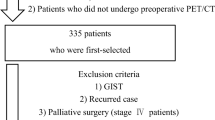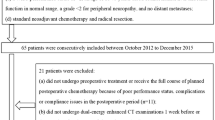Abstract
Purpose
Usefulness of FDG PET-CT in monitoring response in locally advanced gastric cancer has been reported. The purpose of this study was to evaluate the related factors to detect measurable diseases in advanced gastric cancer on FDG PET-CT.
Methods
We retrospectively reviewed 38 patients diagnosed as having advanced gastric cancer. We defined the measurable diseases when there was visualized tumor of which maximum standardized uptake value (SUVmax) was higher than 1.35*SUVmax of liver + 2*SD of liver SUV. We evaluated what kinds of factors from the clinicopathologic features were related to identifying measurable diseases.
Results
Of 38 patients with advanced gastric cancer, 18 (50 %) had measurable tumors on FDG PET-CT. Measurable tumors were significantly more frequent in well or moderately differentiated adenocarcinoma (70.5 % vs 35.3 %, p < 0.05), in the tumors located at antrum or angle (66.7 % vs 29.4 %, p < 0.05) and in the elderly group (age of 55 years old or more, 72.0 % vs 8.3 %, p < 0.001) than the others, respectively. By multivariate analysis, age at diagnosis was the only independent predictor for the measurable disease on FDG PET-CT.
Conclusion
We found that age at diagnosis, as well as histologic types and location of tumors, were the affecting factors to detect measurable disease on FDG PET-CT in patients with advanced gastric cancer. Our study suggests that elderly patients of age of 55 years old or more can frequently have T-measurable disease on FDG PET-CT in advanced gastric cancer and FDG PET-CT will be helpful to monitor measurable disease.




Similar content being viewed by others
References
Couper GW, McAteer D, Wallis F, Norton M, Welsh A, Nicolson M, et al. The detection of response to chemotherapy using positron emission tomography in patients with oesophageal and gastric cancer. Brit J Surg. 1998;85:31.
Lordick F, Ott K, Krause BJ, Weber WA, Becker K, Stein HJ, et al. PET to assess early metabolic response and to guide treatment of adenocarcinoma of the oesophagogastric junction: the MUNICON phase II trial. Lancet Oncol. 2007;8(9):797–805. doi:10.1016/S1470-2045(07)70244-9.
Ott K, Fink U, Becker K, Stahl A, Dittler HJ, Busch R, et al. Prediction of response to preoperative chemotherapy in gastric carcinoma by metabolic imaging: results of a prospective trial. J Clin Oncol Off J Am Soc Clin Oncol. 2003;21(24):4604–10. doi:10.1200/JCO.2003.06.574.
Ott K, Herrmann K, Lordick F, Wieder H, Weber WA, Becker K, et al. Early metabolic response evaluation by fluorine-18 fluorodeoxyglucose positron emission tomography allows in vivo testing of chemosensitivity in gastric cancer: long-term results of a prospective study. Clin Cancer Res Off J Am Assoc Cancer Res. 2008;14(7):2012–8. doi:10.1158/1078-0432.CCR-07-0934.
Ott K, Weber WA, Lordick F, Becker K, Busch R, Herrmann K, et al. Metabolic imaging predicts response, survival, and recurrence in adenocarcinomas of the esophagogastric junction. Journal of Clinical Oncology: Official Journal of the American Society of Clinical Oncology. 2006;24(29):4692–8. doi:10.1200/JCO.2006.06.7801.
Weber WA, Ott K, Becker K, Dittler HJ, Helmberger H, Avril NE, et al. Prediction of response to preoperative chemotherapy in adenocarcinomas of the esophagogastric junction by metabolic imaging. Journal of Clinical Oncology: Official Journal of the American Society of Clinical Oncology. 2001;19(12):3058–65.
Yun M, Kim T-S, Hwang H-S. Clinical Application of 18 F-FDG PET in Gastric Cancer. Nucl Med Mol Imaging. 2008;42 suppl 1:39–45.
Chen J, Cheong JH, Yun MJ, Kim J, Lim JS, Hyung WJ, et al. Improvement in preoperative staging of gastric adenocarcinoma with positron emission tomography. Cancer. 2005;103(11):2383–90. doi:10.1002/Cncr.21074.
Mochiki E, Kuwano H, Katoh H, Asao T, Oriuchi N, Endo K. Evaluation of 18 F-2-deoxy-2-fluoro-D-glucose positron emission tomography for gastric cancer. World J Surg. 2004;28(3):247–53. doi:10.1007/s00268-003-7191-5.
Mukai K, Ishida Y, Okajima K, Isozaki H, Morimoto T, Nishiyama S. Usefulness of preoperative FDG-PET for detection of gastric cancer. Gastric Cancer Off J Int Gastric Cancer Assoc Jpn Gastric Cancer Assoc. 2006;9(3):192–6. doi:10.1007/s10120-006-0374-7.
Stahl A, Ott K, Weber WA, Becker K, Link T, Siewert JR, et al. FDG PET imaging of locally advanced gastric carcinomas: correlation with endoscopic and histopathological findings. Eur J Nucl Med Mol Imaging. 2003;30(2):288–95. doi:10.1007/s00259-002-1029-5.
Yeung HW, Macapinlac H, Karpeh M, Finn RD, Larson SM. Accuracy of FDG-PET in gastric cancer. Preliminary experience. Clin Positron Imaging Off J Int Clin PET. 1998;1(4):213–21.
Chae MJ, Cheon GJ, SwL MD, Byun BH, Kim S, Kim YC, et al. Patterns of FDG uptake in stomach on F-18 FDG positron emission tomography: correlation with endoscopic findings. Korean J Nucl Med. 2005;39(6):456–63.
Yun M, Choi HS, Yoo E, Bong JK, Ryu YH, Lee JD. The role of gastric distention in differentiating recurrent tumor from physiologic uptake in the remnant stomach on 18 F-FDG PET. J Nucl Med Off Publ Soc Nucl Med. 2005;46(6):953–7.
Han E-J, Cho W-H, Chung Y-A, Kim K-J, Maeng L-S, Sohn K-M, et al. Comparison between FDG uptake and clinicopathologic and immunohistochemical parameters in pre-operative PET/CT scan of primary gastric carcinoma. Nucl Med Mol Imaging. 2009;43(1):26–34.
Koga H, Sasaki M, Kuwabara Y, Hiraka K, Nakagawa M, Abe K, et al. An analysis of the physiological FDG uptake pattern in the stomach. Ann Nucl Med. 2003;17(8):733–8.
Milne AN, Sitarz R, Carvalho R, Carneiro F, Offerhaus GJ. Early onset gastric cancer: on the road to unraveling gastric carcinogenesis. Current Mol Med. 2007;7(1):15–28.
Kokkola A, Sipponen P. Gastric carcinoma in young adults. Hepato-Gastroenterology. 2001;48(42):1552–5.
Correa P, Shiao YH. Phenotypic and genotypic events in gastric carcinogenesis. Cancer Res. 1994;54(7 Suppl):1941s–3.
Acknowledgment
This work was supported in part by Clinical Investigation grant funded by Korea University College of Medicine. We had no conflict of interest.
Conflict of Interest
The authors declare that they have no conflict of interest.
Author information
Authors and Affiliations
Corresponding author
Rights and permissions
About this article
Cite this article
Oh, S.Y., Cheon, G.J., Kim, Y.C. et al. Detectability of T-Measurable Diseases in Advanced Gastric Cancer on FDG PET-CT. Nucl Med Mol Imaging 46, 261–268 (2012). https://doi.org/10.1007/s13139-012-0149-5
Received:
Revised:
Accepted:
Published:
Issue Date:
DOI: https://doi.org/10.1007/s13139-012-0149-5




